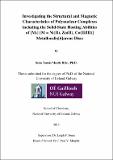| dc.description.abstract | We report the synthesis, structural and magnetic characterisation of a family of planar, pseudo metallocalix[6]arene disc-like complexes (1-10 and 14-21) of general formula [M7(OH)6(Lx)6](NO3)2 {M = Ni(II), Zn(II), Co(II/III)} and LxH are Schiff base ligands: L1H = 2-iminomethyl-6-methoxyphenol, L2H = 4-bromo-2-iminomethyl-6-methoxyphenol, L3H = 2-iminophenyl-6-methoxyphenol). Each member exhibits a double-bowl pseudo metallocalix[6]arene topology of which the [M(II)7] units in complexes 1-8 stack on top of one another to generate molecular host cavities in the solid-state, capable of encapsulating a wide variety of guest molecules (MeCN, NO2Me, MeOH). Encapsulation of the reactive aromatic species 2-Furaldehyde and 3-Furaldehyde was also achieved in the form of complexes 14-18; presence of guest furaldehyde species being detected via spectroscopic methods. Dc magnetic susceptibility measurements were performed on complexes 2, 4, 8 and 9 which revealed weak ferromagnetic intramolecular exchange between the Ni(II) ions in both complexes [(MeOH)2¿Ni(II)7(OH)6(L1)6](NO3)2 (2) and [(MeCN)2¿Ni(II)7(OH)6(L2)6](NO3)2 (4), while similar studies on complexes (8-9) revealed weak ferro- and ferrimagnetic behaviour respectively. The ¿¿¿ notation is used to indicate guest presence. Attempts at extending the molecular cavities present in these systems via functionalisation of the utilised Schiff base ligand, led to the isolation of the heptanuclear complexes (19-21) of general formula [M(II)7(OMe)4(OEt)2(L4)6](NO3)2 (where M = Ni(II), Zn(II), Co(II) and L4H = 4-phenyl-2-iminomethyl-6-methoxyphenol).
In efforts to expand our family of solid-state host-guest disc-like complexes the Schiff base ligand was further functionalised and other M(II) salt precursors were utilised. These investigations instead afforded entirely different complex topologies including the heterometallic tetranuclear complexes of general formula [Na(I)2M2(X)2(L1)4(Y)2] {where M = Fe(III), X = MeO-, Y = NO3- (24); M = Ni(II), X = N3- and Y = MeCN (25)}, each comprising the molecular butterfly topology. Magnetic susceptibility measurements of these complexes highlight antiferromagnetic and ferromagnetic coupling in 24 and 25 respectively, with the inclusion of the azide bridging anion (N3-) in the latter affording the observed ferromagnetic coupling between the Ni(II) ions. We also report the formation of the heterometallic molecular cage [Na(I)3Ni(II)2(L1)6](ClO4) (28) which exhibits a rare trigonal bipyramidal core topology. In addition we report the isolation of the tetranuclear cubane clusters [Mn(III)3Mn(IV)1(O)3(OEt)(OAc)3(L1)3] (30) and [Ni(II)4(µ3-OMe)4(L5)4(MeOH)4] (32) (where L5H = 2-imino-6-methoxyphenol). Dc and ac magnetic susceptibility studies on complexes 30 and 32 reveal S = 9/2 and S = 4 spin ground states, as a result of ferri- and ferromagnetic exchange coupling in complexes 30 and 32 respectively. | en_US |


